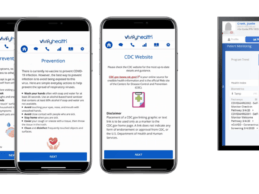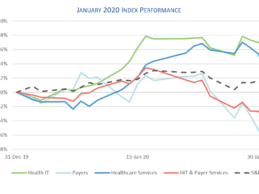What You Need to Know:
- In response to the coronavirus (COVID-19) pandemic, Teladoc Health reports that its daily virtual medical visit volume has spiked 50% over the prior week.
- Teladoc Health has provided approximately 100,000 virtual medical visits to patients in the United States in the past week.
Virtual
care provider Teladoc Health
announced that the company is experiencing unprecedented daily visit volume in
the United States as the novel coronavirus (COVID-19) continues
Read More
HHS
Vivify Health Launches COVID-19 Screening, Self-Isolation and Monitoring Pathways
What You Need to Know:
- Vivify Health has announced that availability today of new COVID-19 Screening, Self-Isolation and Monitoring Pathways for Vivify+Go mobile solution to providers at non-cost.
- This enables low-risk patients or those with mild symptoms to use their mobile devices to self-screen for COVID-19 by answering a series of questions that follow the current Centers for Disease Control and Prevention (CDC) guidelines.
- The self-screening helps providers scale their
Read More
6 Coronavirus (COVID-19) Considerations for Telehealth Providers
As the novel coronavirus outbreak continues, the federal government and commercial health insurers have taken significant steps to increase Americans’ access to treatment and testing. In the past week, the federal government and private insurers have issued a number of guidance documents expanding coverage and payment requirements in an effort to minimize the spread of the virus.
As with any changes in coverage and reimbursement, healthcare providers offering telehealth services should
Read More
Using Health IT to Preserve Antibiotics and Fight Drug-Resistance
In its latest report on antibiotic resistance, the CDC revealed that infection rates for many threat pathogens are stagnant or in a nominal decline. While this is promising news, there are still a startling 2.8 million cases of drug-resistant infections predicted this year, which will result in an estimated 35,000 deaths. What’s more, the speed at which some patients are developing resistance to last-resort antibiotics – those that are often reserved for special scenarios and designed
Read More
Patient Data Liberation: HHS Releases Final Interoperability & Patient Access Rules
What You Need to Know:
- HHS finalizes interoperability rules that will implement interoperability and patient access provisions of the bipartisan 21st Century Cures Act (Cures Act) and support President Trump’s MyHealthEData initiative.
- The ONC Final Rule identifies and finalizes the reasonable and necessary activities that do not constitute information blocking while establishing new rules to prevent “information blocking” practices (e.g., anti-competitive behaviors) by
Read More
HHS Issues Strategies & Recommendations to Mitigate EHR-Related Clinician Burden
- HHS issues new report outlining the key sources of EHR-related burden, as well as strategies and recommendations to achieve burden reduction goals for healthcare providers.
- The HHS report reflects additional input from the more than 200 comments submitted in response to the draft strategy and recommendations.
As part of the
ongoing efforts to strengthen the relationship between patients and their
doctors, the U.S. Department of Health and Human
Services (HHS) issued
Read More
Black History Month: Social Determinants of Health, The African American Experience
For the sake of history and, the auspices of a bountiful potential of a great people of a Great Nation may there be boldness and courage in the noble battle waged to address social determinants of health within US healthcare? History has revealed the health and well being of a Nation and its people is as important as matters of national security.
Thus, stands the profound import of equitable access to good health and wellness within the United States of America and Nations around the world.
Read More
Analysis: January Health IT M&A Activity; Public Company Performance
– Healthcare Growth Partners’ (HGP) summary of Health IT/digital health mergers & acquisition (M&A) activity, and public company performance during the month of January 2020.
Ten years into the bull market, we operate in a heightened state of awareness for any indication of market weakness that may signal a downturn. While debt levels are rising and GDP growth somewhat sluggish, the world of private equity, public equity, and M&A continues to be in full swing bull market
Read More
Executive Insights: Top Healthcare Predictions & Trends to Watch in 2020
As we close out the year, we asked several healthcare industry executives to share their predictions and trends for 2020.
Robbie Hughes, Founder, and CEO, Lumeon
“Following the announcement of the Trump administration's price transparency requirement – and the ensuing backlash from hospital groups – the issue of price transparency will dominate the healthcare industry next year. Regardless of the outcome of the lawsuit, I expect we'll see more attention around the importance of the
Read More
House Lifts Ban on Funding of NPI System: 7 Implications to Know
The House of Representatives recently voted to lift a ban prohibiting funding for a national patient identifier system (NPI) designed to improve patient matching.
So, what does that mean moving forward?
Let’s dive into the implications of the House’s vote.
What Will an NPI System Do?
Now that the House has lifted the ban on the U.S. Department of Health and Human Services (HHS) providing funding a national patient identifier, it’s important to become familiar with exactly what an NPI system
Read More










